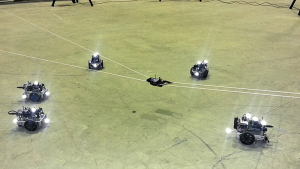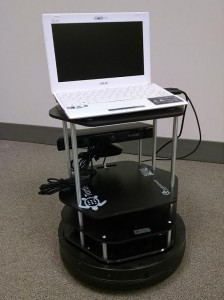 In December, a group of Iowa State graduate and undergraduate students gathered at the Applied Science Complex to demonstrate their passion for making robots smarter and more autonomous. The event was the first “Rise of Machines” robotics competition, organized by Professor Sourabh Bhattacharya, an assistant professor of mechanical engineering who has been developing a cutting edge research program at ISU in the area of multi-robot systems.
In December, a group of Iowa State graduate and undergraduate students gathered at the Applied Science Complex to demonstrate their passion for making robots smarter and more autonomous. The event was the first “Rise of Machines” robotics competition, organized by Professor Sourabh Bhattacharya, an assistant professor of mechanical engineering who has been developing a cutting edge research program at ISU in the area of multi-robot systems.
“This marks the beginning of a new effort in the Department of Mechanical Engineering in the area of autonomy. This competition provides a great opportunity for the students to become engaged in robotics,” said Caroline Hayes, chair of the mechanical engineering department and Lynn Gleason Professor of Interdisciplinary Engineering. Hayes, who earned a PhD in robotics from Carnegie Mellon University, has been extremely supportive of this competition, as well as similar efforts in the department to foster student interest in robotics.
 “These students have really worked hard to compete in this event,” said Bhattacharya, who organized this event as a final project presentation for the Automatic Controls course offered in the department. “In addition to the assignments, exams and labs in the course, the students had to learn hardware programming, interfacing and algorithm design to compete in the event. This requires a steep learning curve on their part given the fact that they have no prior background in these areas,” Bhattacharya added.
“These students have really worked hard to compete in this event,” said Bhattacharya, who organized this event as a final project presentation for the Automatic Controls course offered in the department. “In addition to the assignments, exams and labs in the course, the students had to learn hardware programming, interfacing and algorithm design to compete in the event. This requires a steep learning curve on their part given the fact that they have no prior background in these areas,” Bhattacharya added.
“It is invaluable to witness them progressing in the project. What they have achieved in a semester is impressive, and it is the result of their hard work,” said Rui Zou, a graduate student in mechanical engineering who was actively engaged in organizing this event.
 Participants comprised student teams from various departments in the College of Engineering, at the graduate and undergraduate levels. In the semi-autonomous category, the winner of the competition was “Bo the Bot,” a robot designed and programmed by Andrew Patience and Steven Lindner, both ME undergraduates. Their robot finished the maze in less than a minute. “We just lost the first position by 2 seconds,” said Keith Lansing, a graduate student in ABE, whose robot Optimus Prime finished a close second. “We were having better finishing times during the practice runs,” said Lansing’s teammate Nick Orlowsky, an undergraduate student in mechanical engineering.
Participants comprised student teams from various departments in the College of Engineering, at the graduate and undergraduate levels. In the semi-autonomous category, the winner of the competition was “Bo the Bot,” a robot designed and programmed by Andrew Patience and Steven Lindner, both ME undergraduates. Their robot finished the maze in less than a minute. “We just lost the first position by 2 seconds,” said Keith Lansing, a graduate student in ABE, whose robot Optimus Prime finished a close second. “We were having better finishing times during the practice runs,” said Lansing’s teammate Nick Orlowsky, an undergraduate student in mechanical engineering.
In the autonomous category, the winner was MOLI, a robot programmed by Katherine Hinkle (Grad, ABE) and Dillon Worth (Undergrad, ME). John Deutsch (Grad, ABE) and Dustin Monat (Undergrad, ME) secured the second position in the autonomous category with their robot hoiBORG.
Several faculty members attended the competition, and engaged in thought-provoking discussions with each team regarding the control and navigation algorithms designed by the students for the robots.
 “The Rise of Machines robotics competition being the first of its kind at ISU truly presented an excellent opportunity to students to apply their classroom learning of automation and control theory to practice. The motivated performances of student teams clearly showed how much they enjoyed this holistic learning process. I really hope that the platform thrives and grows in future so that many more students can have this unique experience,” said Soumik Sarkar, who joined the department last Fall. “Can we have flying robots navigate through three dimensional mazes in the coming years as a part of the competition?” said Adarsh Krishnamurthy, another new hire in the department.
“The Rise of Machines robotics competition being the first of its kind at ISU truly presented an excellent opportunity to students to apply their classroom learning of automation and control theory to practice. The motivated performances of student teams clearly showed how much they enjoyed this holistic learning process. I really hope that the platform thrives and grows in future so that many more students can have this unique experience,” said Soumik Sarkar, who joined the department last Fall. “Can we have flying robots navigate through three dimensional mazes in the coming years as a part of the competition?” said Adarsh Krishnamurthy, another new hire in the department.
In addition to staff and faculty members, the event also generated some curiosity among local school children. Stevn Schroeder, a sixth-grade student from Boone, was present to cheer for his favorite team. “I am interested in seeing the type of robots built by the college students. I hope to do the robotic section for one of my robotic modules in the Industrial Arts class,” Schroeder said.
Bhattacharya hopes the competition will become an annual event in the future as a part of ISU’s outreach efforts. “By having various categories and levels in the competition, we can attract K-12 participants from the neighboring counties,” Bhattacharya said. “This will serve as a great platform to raise awareness and enthusiasm among the local kids regarding STEM fields.”
